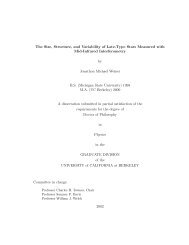Astro 160: The Physics of Stars
Astro 160: The Physics of Stars
Astro 160: The Physics of Stars
You also want an ePaper? Increase the reach of your titles
YUMPU automatically turns print PDFs into web optimized ePapers that Google loves.
we findρ c ≈ 77.26 g/cm 3 P c ≈ 1.24 × 10 15 T c ≈ 1.02 × 10 7 Kthus we can see that the γ = 4/3 polytrope best represents the values observed in the sun, this is mainlydue to the fact that the center <strong>of</strong> the sun is radiative and not convective. Since we now know thatP ∝ ρ 4/3 radiativeP ∝ ρ 5/3 convectiveProblem # 4Consider a pre-main sequence “star” (gas cloud) <strong>of</strong> mass M undergoing Kelvin-Helmholz contraction.In class, we showed that fully convective stars move down the Hayashi line with T e f f ≈ constant. Butstars with M > 0.3M sun do not end up fully convective on the main sequence and so must go througha phase <strong>of</strong> KH contraction in which energy transport is dominated by photons. Assume throughout thisproblem that gas pressure dominates and that free-free ab- sorption dominates the opacity (because thetemperature is lower during KH contraction than on the main sequence, free-free absorption tends tobe even more important). Motivated by HW #2 Problem 1, assume that the luminosity <strong>of</strong> a star inwhich photons carry the energy out and the opacity is dominated by free-free absorption is given byL ≈ L sun (M/M sun ) 11/2 (R/R sun ) −1/2 .(a). Determine how the radius, luminosity, and effective temperature vary as a function <strong>of</strong> time andmass M for a radiative star undergoing KH contraction. Don’t worry about the constants in these relations;all you need to calculate are proportionalities (i.e., how do the various quantities depend on time and massM). Do the luminosity and effective temperature increase or decrease as the star contracts?since we know thatthus we know thatP g > P rκ = κ f f( ) M 11/2 ( ) R −1/2L f f ≈ L sun ≈ L rad ≈ − 1 GM 2 dRM sun R sun 2 R 2 dtsince we are doing proportionalities we findso we find that the radius scales asplugging this intothusand to find the temperatureM 2 RR 2 t T ∝ M11/2 R −1/2R ∝ 1M 7 t 2L ∝ M 11/2 R −1/2 ∝ M 9 tL ∝ M 9 tL ∝ R 2 T 4e f f( ) L 1/4T e f f ∝R 2 ∝ M 23/4 t 5/418












![Problem #1 [Structure Formation I: Radiation Era]](https://img.yumpu.com/37147371/1/190x245/problem-1-structure-formation-i-radiation-era.jpg?quality=85)



